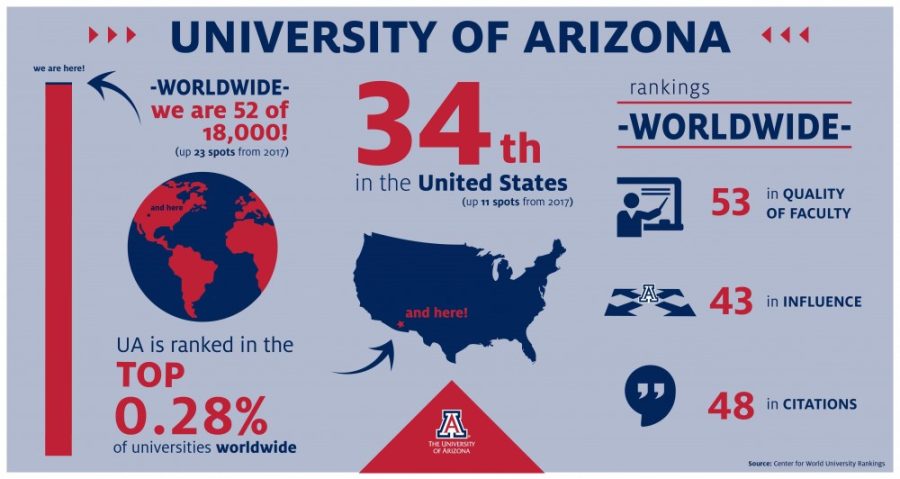The University of Arizona is the 52nd best university on Earth, according to a new set of rankings compiled by the Center for World University Rankings. The ranking is an improvement of 23 spots from 2017’s list.
That puts the UA in the top one percent of 18,000 universities polled by CWUR worldwide. Nationally, the UA came in at 34, a jump of 11 spots from last year.
In a press release, UA President Dr. Robert Robbins called the designation “a fantastic reflection of the incredible talent we have here at the UA,” before praising faculty and their research.
RELATED: Top 5: The five biggest news stories to hit campus in 2017-2018
The ranking, Robbins said, “strengthens our position as becoming a global leader in the Fourth Industrial Revolution, and we will continue our climb among the ranks of the world’s premier universities.”
The United Arab Emirates-based CWUR has compiled its list of the 1,000 best universities in the world since 2014. A primary reason for the positive spike in this year’s ranking was the amount and quality of research work done by faculty.
In the categories “Quality Publications” and “Quality of Faculty,” UA made significant progress, moving up eight and fifteen spots, respectively.
UA’s Interim Provost Jeff Goldberg said that this ranking, coupled with strong showings in other publications and website lists, are a positive sign of growth for UA, which helps with recruiting.
“We want students to see these, they’re important, especially for out-of-state and international students,” he said. “It helps when families see these rankings, they act as sort of a surrogate for bringing students in.”
Rankings and lists like CWURs also help in recruiting another important population: faculty. Goldberg said that, with strong showings in categories that measure faculty output and prestige, the rankings attract more and more high quality faculty across disciplines.
Methodology
CWUR uses a methodology based on seven criteria, with six weighted at 15 percent of the score, and one, “Citations,” weighted at 10 percent.
Unlike similar rankings such as U.S. News and World Report, CWUR’s methodology is unique. The center puts emphasis on the quality of student education, by measuring a metric called “Quality Education.”
Defined on CWUR’s website as a measure of “the number of a university’s alumni who have won major international awards, prizes, and medals relative to the university’s size,” in this category, UA lost ground, falling 64 spots to 166th overall.
Goldberg said that while the metric may help measure an institution’s highest performers, it gives short shrift to the average UA graduate. He called the category a summary of “alumni who have won big prizes,” like a Nobel.
“It’s really a measure of [a university’s] top performers,” he said. “It doesn’t do much to tell you how the average or even the 75th percentile graduate is doing.”
CWUR also differs from U.S. News and another major player in the college ranking industry, the Princeton Review, in that it does not use data self-reported by the institutions it ranks.
In explaining its methodology, the center criticizes another ranking aggregator for relying too heavily “on surveys, which make up about one-third of its analysis. Roughly another third is made up of data submitted by universities, which could be manipulated in order to move up in the ranking.”
Pac-12 and Peer institutions
Finishing 52 in the world places the UA in rarefied air internationally; however, it’s a different story in comparison to nearby and peer universities. Still, UA did come in more than 50 spots higher than Arizona State University (which finished 114th).
Although the Pac-12 conference is a grouping of large, West Coast universities for purposes of athletics, eight of the conferences member institutions are part of the prestigious Association of American Universities.
According to the CWURs rankings, Stanford University is the highest rated institution in the Pac-12, coming in 2nd overall — followed by its Bay Area rival the University of California, Berkeley (6th overall).
Rounding out the top half of the conference were UCLA (15th), the University of Washington (19th), the University of Colorado (50th) and the University of Southern California (51st).
That puts the UA just out of the upper academic tier of the conference, although sharply ahead of the University of Oregon, which finished last in the conference at 428th.
RELATED: Campus Services: From A to Z
It’s a similar story when UA is compared to its peer institutions, as determined by the Arizona Board of Regents. Nine of UA’s 15 peer institutions finished higher in the CWURs rankings.
While rankings like these and others are great for recruiting of both students and faculty, Goldberg said there is a more important role to the prospective — and current — student.
The rankings “don’t look like they affect the every-day goings-on,” he said. “But if we do the right things, it will mean faculty and staff are providing a world-class education and experience for students.”
Follow Eddie Celaya on Twitter









